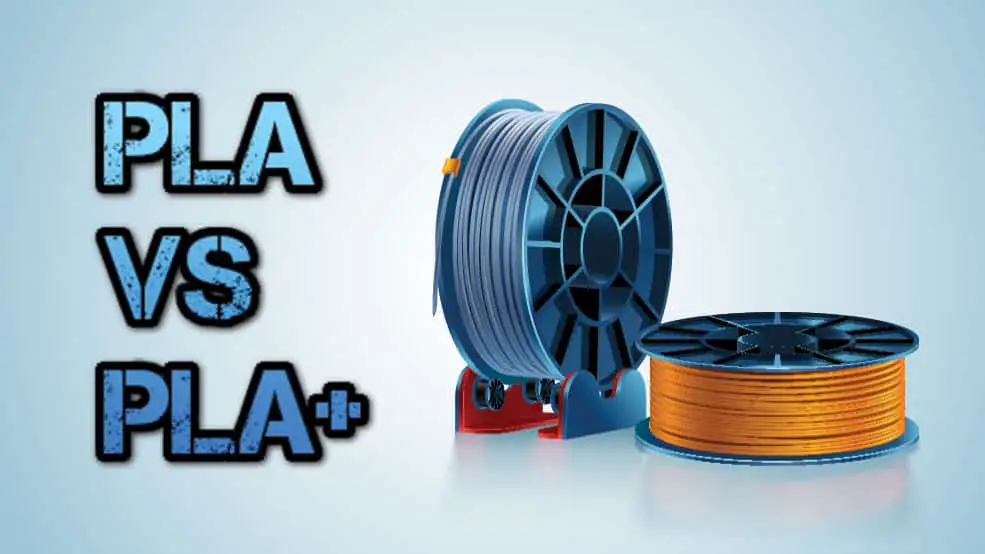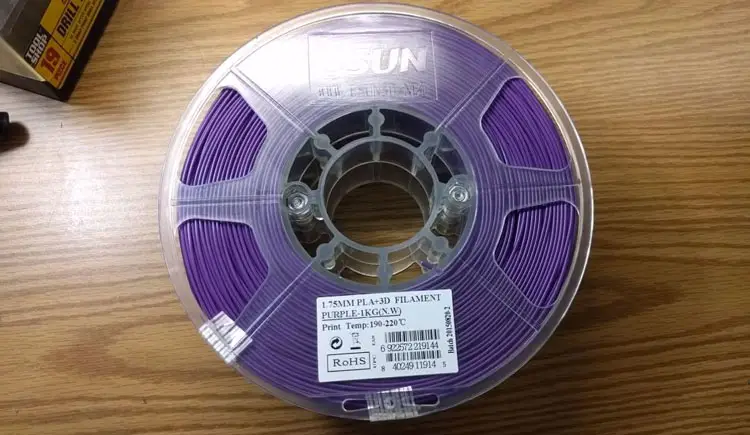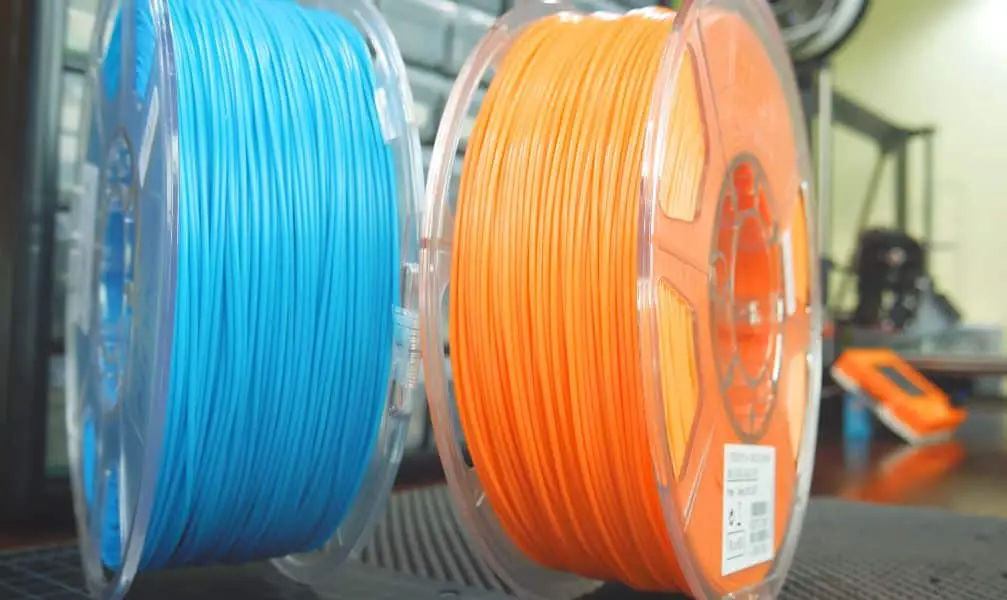
FDM printers use various different filament types but the two most common are ABS and regular PLA. Both of these filament materials are described as thermoplastics and this means that when they are exposed to high temperatures they become malleable. In other words, it can be molded into various shapes.
We’re going to be looking in more detail at the PLA filament type in this article and how it compares up to PLA+, the supposedly new and enhanced filament. Many 3D fanatics are saying that this PLA plus offers better quality than the standard PLA filament. Others can’t quite seem to make up their mind when it comes to PLA vs PLA+. We’ll look to try and make this a discussion a bit more definitive and clear up any doubts as to what PLA plus actually is and whether, in fact, it is superior to PLA.

What is Standard PLA
Standard PLA is technically known as polylactic acid in the science world. It’s a thermoplastic polymer which is made from either sugar cane or corn starch. This puts PLA high up on the “good materials to use” list because they are made from renewable resources. Of course, both of which are very friendly to the environment we live in.
There are indeed more expensive filaments and cheap 3D filament that you need to be aware of. I would advise against finding the cheapest 3D filaments you can.
In order to create the PLA filament, a granulated, raw, clear resin is mixed with pigments and additives in a machine not too dissimilar to a blender. This mixture gives the standard PLA its specific color and mechanical characteristics.
To obtain the final consistency, the mixture is dried at 60-80°C and is then mixed and heated again inside an extruder ready to be processed into the solid filament form. The extruded filament is finally cooled down and coiled onto a spool which resembles the PLA filament that we know and buy online or down at the shops.
The characteristics of PLA is often described as glossy and this consistency allows it to flow smoothly from the 3D printing nozzle. It works well for detailed objects, especially with sharp corners. Standard PLA filament only requires a low printing temperature and is often regarded as the “standard” 3D printing material for home use.
It’s a great starting material for beginners because it’s easy to use and affordable. However, like with all technology and materials, most things get superseded with new and “modern” ideas. People are always looking to improve the 3D printing process and this is where PLA plus fits in. What exactly is PLA plus and is it any different to PLA? Let’s take a look.
What is PLA Plus

Confusingly, there is no actual official formula for PLA+ compared to PLA and it seems to be different from one company to the next. We can’t see any difference in the way PLA and PLA+ filaments are created apart from the additional additives that are included to make the initial blended PLA mixture.
These additional plastics, additives, and pigments that have been included all help to improve the original PLA makeup. You might find some PLA+ to be extra glossy, you might find others that offer twice as much strength. It seems that there is no set “ingredients” list for PLA+, yet.
In regards to the printing process then we don’t see any difference at all. The 3D printing speed and temperatures are practically the same but it’s the overall post-print effect that shows why PLA+ itself is more advanced.
The surface tends to be smoother and the colors sometimes seem richer. However, all of this depends on the individual PLA+ filament and exactly what was added to that particular PLA mix. These PLA+ mixtures are kept a secret from company to company so nobody can say what PLA+ actually consists of. There is no standardization and this is where the confusion stems from.
Most people who have used PLA+ say that it is better than normal PLA but we as consumers still run the risk of buying one PLA plus filament that prints differently from another PLA plus filament. Therefore we need to be extra careful and buy these PLA+ filaments from the same company in order to keep some form of consistency in our 3D models.
Known PLA+ Characteristics
- Smoother surface
- Better for overhanging designs like bridges for example
- Typically higher printing temperature
- Extra glossy reflection that helps to show off more detail
- Stronger with bending capabilities
Popular PLA Plus Brands
PLA plus does make a difference and although we’re not entirely sure what the extra “+” means in terms of materials used, we are impressed with the benefits that it brings to the table in terms of filament quality. We’ve included a list of some of the popular PLA+ filament brands that many people have grown to love. The marketing message is quite clear and the majority of them claim to be stronger, more durable, less likely to break and it also gives you better layer adhesion.
- eSUN PLA
- Filaform PLA+
- 3D Fillies PLA+
- KODAK PLA+
- ICE PLA+
- Inland Blue PLA+
Our Final Thoughts

PLA+ is often coined as the “missing link” between the other common 3D printing material such as normal PLA and ABS. Until someone with authority actually comes up with an official statement we’re all going to be left in the dark as to what PLA plus actually is.
For now, we shouldn’t worry too much because it seems that this new and improved formula is indeed stronger and offers a higher quality print than standard PLA. We just want a bit more clarity on the subject to make sure there is some consistency in the materials we buy. One type of PLA+ has the potential to print something with a lot higher quality than another PLA+ and this will only lead to confusion between companies and 3D print hobbyists.
Overall, the general consensus is that PLA plus is very much the new and improved PLA. It offers the user a lot more consistency when printing and the end result is a lot more forgiving in the sense that it’s a lot harder to break.
Nobody can really complain about using a filament that promotes those kinds of benefits. However, we’ll have to wait until someone with 3D printing authority makes an official statement to find out what the actual differences are in this ongoing normal PLA vs PLA+ discussion. To be continued!
Recommended Reading
The Best Methods for PLA Smoothing
There are four main methods for smoothing 3D prints that we most often use, and these are also the ones that we recommend to our readers.
Extruder Calibration – is it Worth it?
You might think it's a hassle to do extruder calibrations. But what if we tell you this process has vital benefits for your printing performance?
PETG vs PLA Filament: What’s the Difference?
What are the main advantages and disadvantages when it comes to PETG vs PLA filament? Let's jump into it!!
How to Clean 3d Printer Bed (Full Guide)
If you continue on you’ll see I have compiled a list on how to clean 3D printer bed and the most useful tactics to accomplish this task.
Direct Vs Bowden Extruder. Which Is Better?
Extruders are one of the most important elements of a 3D printer. There are two types of extruders that we’ll be looking at, Direct and Bowden.
3d Printing With Hatchbox Wood Filament – Should You Buy It?
Hatchbox wood filament is an excellent 3D printing material that you should try out at some stage in your 3D printing career. Check out what it has to offer
